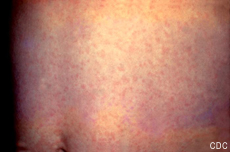WAO Publications | World Allergy Organization
See five (5) causes of food allergy in children: cow’s milk, wheat, egg, soy, peanuts and hard nuts.
Urticaria –angioedema 3 cases.
Thursday, February 5, 2015
THE ALLERGIC TENSION - FATIGUE SYNDROME by Frederic Speer, MD. USA.
ALLERGY AND BEHAVIOR BY FRED J. KITTLER CHAPTER 44 in
ALLERGY AND IMMUNOLOGY IN CHILDHOOD in FREDERIC SPEER,M.D. and
.
ROBERT J. DOCKHORN, MD. University of Kansas and Children’s Mercy Hospital,
Kansas City Kansas & Kansas City Missouri. 1 973. CHARLES C THOMAS
PUBLISHER Illinois. USA.
The child with behavior problems has been examined from a variety of viewpoints by pediatricians, psychologists, and psychiatrists. Genetic inheritance, environment, pampering, sight, and hearing have been studied meticulously. The ego, interpersonal relations, and the psyche have been dissected in many cases, and sometimes the dissection bears fruit. Listless, irritable, and hyperreactive children are brought in vast numbers to psysicians for care, and the management of their behavior disorders is a leading pediatric concern..
Parents and teachers are especially concerned when fatigue or irritability affect the child’s performance in school. On investigation it is often found that the teacher is not able to hold the child’s attention or interest. Instead the child may sit and stare dreamily. An abnormally restless, jittery hyperkinetic child is not only miserable himself but can destroy the study patterns of the entire classroom. Punishment is a common early reaction, because parents feel that the child is naughty or trying to get attention
ALLERGY OF THE NERVOUS SYSTEM by Norman Ward Clein and William G. Crook in THE ALLERGIC CHILD edited by Frederic Speer, M.D. Harper & Row Publishers
Speer, F.: The allergic tension-fatigue syndrome. Pediat. Clinic. North America. I: 1029, 1954.
--------: The allergic tension – fatigue syndrome in children. Internat. Arch. Allergy.
12:207, 1958
As Fred J. Kittler wrote: there is growing awareness, among pediatric allergists at least, of the role allergy plays in causing restlessness and listlessness in children. This has been especially true since Speer helped clarify our thinking by coining a new term, the allergic tension-fatigue syndrome, for an old but previously unnamed allergic syndrome.
Kittler, cites Speer, 1954 Pediatric clinics of North America 1:1029, 1954. Speer cites himself in Allergy Migraine in Headache 11:63, 1971; Allergic Factors in Migraine en Modern Medicine, Feb 8 p. 100, 1971 and ALLERGIC MIGRAINE in ALLERGY AND IMMUNOLOGY IN CHILDHOOD, 1973.
Clein, Speer, Crook, Dees, Glaser, Rowe, Arce y Calzada en El síndrome tensión-fatiga del niño como manifestación alérgica en Anales Casa Salud Valdecilla 16:177, 1955.
Speer , again in Historical development of allergy of the nervous system in Ann. Allergy, 16:14. 1958
Norman W. Clein in COW’S MILK ALLERGY IN INFANTS . Pediatric Clinics of North America. Vol. 1 Number 4, November 1954 References: Abt. I.A.: Milk as a Food for Infants. Chicago M. Rec.March 1912: Alvarez W. C. Puzzling Nervous Storm Due to Allergy. Gastroenterology 7:241, 1946; Speer, Role of Allergy in Infectious Diarrhea of Infancy. J. Kansas M. Soc. Nov. 1952. Rowe; Food Allergy. J.Allergy, 1:172, 1938. Cohen.: Milk Allergy. Am. J. Dis. Child, 38:741, 1929. Ratner, B. Treatment of Milk Allergy and its Basic Principles. J.A.M.A. 105:934, 1935.
Piness G: Allergic Manifestations in Infancy and Chilhood. Arch Ped.42:557, 1925.
Frandland William UK, London, Noon, 1911. Immunotherapy for Pollen Allergy. Watch in youtube: www.alergiascaracasmarketing.blogspot.com, Dr Frandland still alive.
Speer in 1971 outlined the following diseases to be considered in differential diagnosis of The Allergic Tension-Fatigue Syndrome:
Defective vision, defective hearing, mild retardation, malnutrition, intestinal parasites, lead poisoning, sickle-cell anemia, neuroses, , and psychosis. Any type of stress, such as excessive television viewing, family and school problems, and economic deprivation, may need to be considered. Minimal brain damage from diseases in infancy or during the mother’s pregnancy or from meningitis may also need to be thought of.
See five (5) causes of food allergy in children: cow’s milk, wheat, egg, soy, peanuts and hard nuts.
COW´S MILK ALLERGI IN INFANTS . 206 cases presented by Dr. Norman W. Clein in Pediatrics of North America. 1954. Copy handed out to me by Dr Speer, personally.
At his Allergy Clinic, Shwanee- Mission Outlook Street. Kansas City Kansas. USA
Vincent J. Fontana, M.D. director of Pediatric Allergy, Bellevue Hospital , New York, new York, recommended me to Dr Speer.
Follows a resume of Dr. Clein's paper:
Breast milk is not only the best food, but is also the ideal and natural food for the newborn infant. Few infants are allergic to breast milk. even though the mother may be a highly allergic person. Cow's milk is only a substitute for breast milk and as such may present a relatively high degree of allergenicity.
The majority of babies in this country are presently fed on a cow's milk formula in one form or another and do quite well. There are also a relatively large number who suffer simple colic or become desperately ill as a result of an allergy or sensitivity to milk. For many years it has been hinted that cow's milk may disagree with some babies. Abt, in 1 911 mentioned that some infants have an idiosincrasy to cow's milk which produces "toxic symptoms and injuries to the baby". Piness, in 1 925 called attention to allergic manifestation from food in infants. Pediatric textbooks barely mention milk allergy or refer meagerly to minor gastrointestinal symptoms. Several clinical reports have stressed the intestinal manifestations, omitting or barely mentioning any other type of symptoms. The fact remains that allergty to cow's milk is a common cause of symptoms in many infants. A formula ideal for some babies may be another baby's poison.
A critical clinical analysis of 206 infants allergic to cow's milk reveals a multipicity of ordinary or strange, baffling, mild to serious and often apparently unrelated clinical syndromes. Various prolonged, complicated and expensive diagnostic tests, treatments and even operations have been performed in an effort to relieve these unfortunate infants, because allergy to milk was not suspected as a cause of their symptoms. The type and location of symptoms depend on two factors: (1) the tissue or organ affected and (2) the results of the pathologic mechanism of allergic disease on the particular organ or tissue involved ( edema of mucus membranes, spam of smooth muscle and excess mucus secretion ). If the allergic "trigger"area is in the nose, we expect swelling, stuffiness and excess secretions as well as other local and constitutional symptoms that follow.
Below we show the twelve clinical entities described by Dr. Clein:
Breast milk is not only the best food, but is also the ideal and natural food for the newborn infant. Few infants are allergic to breast milk. even though the mother may be a highly allergic person. Cow's milk is only a substitute for breast milk and as such may present a relatively high degree of allergenicity.
The majority of babies in this country are presently fed on a cow's milk formula in one form or another and do quite well. There are also a relatively large number who suffer simple colic or become desperately ill as a result of an allergy or sensitivity to milk. For many years it has been hinted that cow's milk may disagree with some babies. Abt, in 1 911 mentioned that some infants have an idiosincrasy to cow's milk which produces "toxic symptoms and injuries to the baby". Piness, in 1 925 called attention to allergic manifestation from food in infants. Pediatric textbooks barely mention milk allergy or refer meagerly to minor gastrointestinal symptoms. Several clinical reports have stressed the intestinal manifestations, omitting or barely mentioning any other type of symptoms. The fact remains that allergty to cow's milk is a common cause of symptoms in many infants. A formula ideal for some babies may be another baby's poison.
A critical clinical analysis of 206 infants allergic to cow's milk reveals a multipicity of ordinary or strange, baffling, mild to serious and often apparently unrelated clinical syndromes. Various prolonged, complicated and expensive diagnostic tests, treatments and even operations have been performed in an effort to relieve these unfortunate infants, because allergy to milk was not suspected as a cause of their symptoms. The type and location of symptoms depend on two factors: (1) the tissue or organ affected and (2) the results of the pathologic mechanism of allergic disease on the particular organ or tissue involved ( edema of mucus membranes, spam of smooth muscle and excess mucus secretion ). If the allergic "trigger"area is in the nose, we expect swelling, stuffiness and excess secretions as well as other local and constitutional symptoms that follow.
Below we show the twelve clinical entities described by Dr. Clein:
Eczema 91 cases
Pylorospasm 78 cases
Colic 65 cases
Diarrhea 47 cases
Very unhappy all the time, 40 cases
Cough, croup, choking, gagging, excess mucus in throat 36 cases
Nose cold all the time, 27 cases
Constipation 10 cases
Asthma 15 cases
Refuses milk entirely – anorexia 7 cases
Toxemia –apathetic, listless, cyanotic, collapse 4 cases
Urticaria –angioedema 3 cases.
Note: I myself have seen these cases in my practice and I have follow the American way of solving them.
For more details see www.alergiascaracasmarketing.blogspot.com,
www.infoguia.com / alergólogos
www.centromedicodecaracas.com.ve, / Alergología
www.worldallergy.org,
www.svaai,org.ve / Carlos E Mijares













